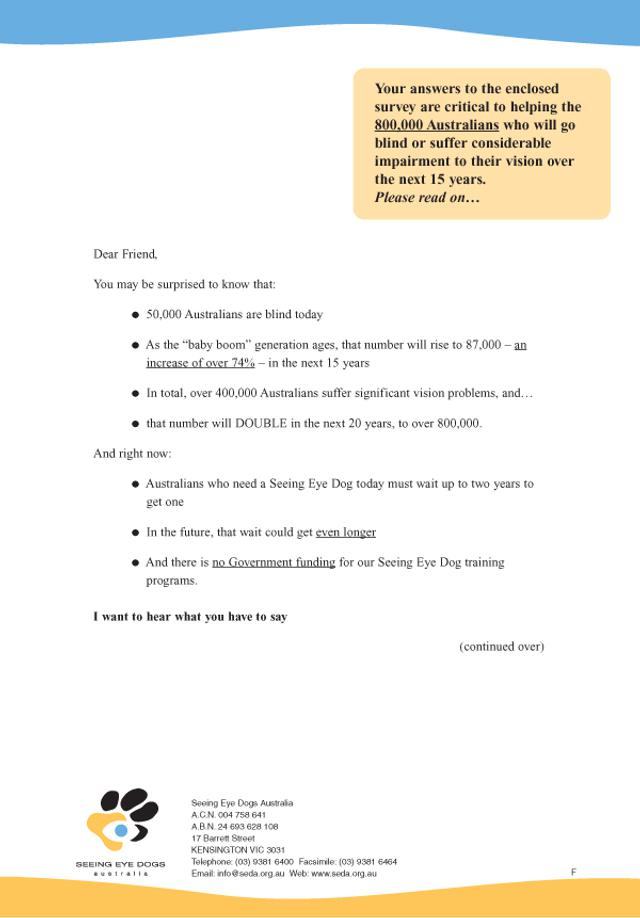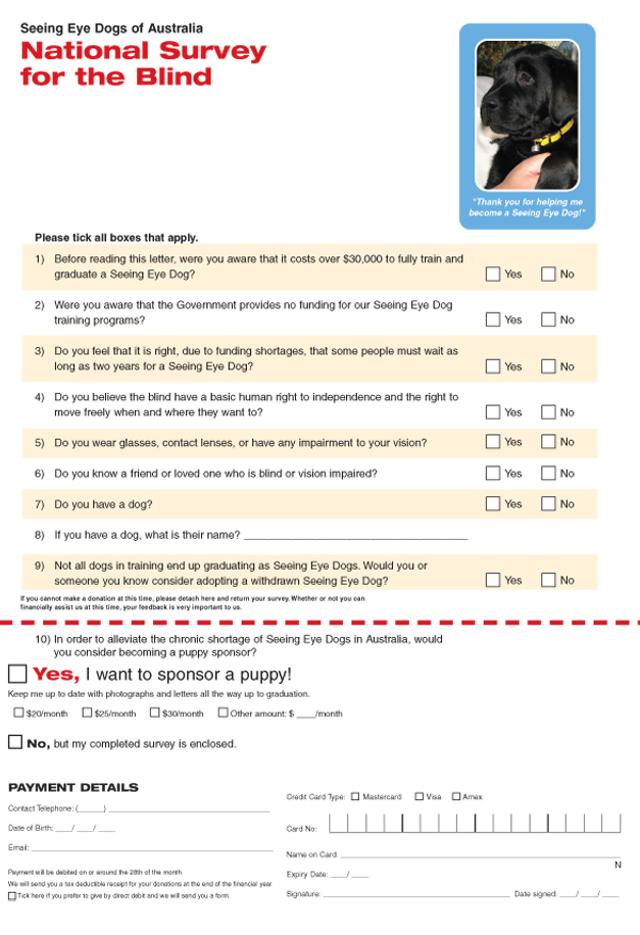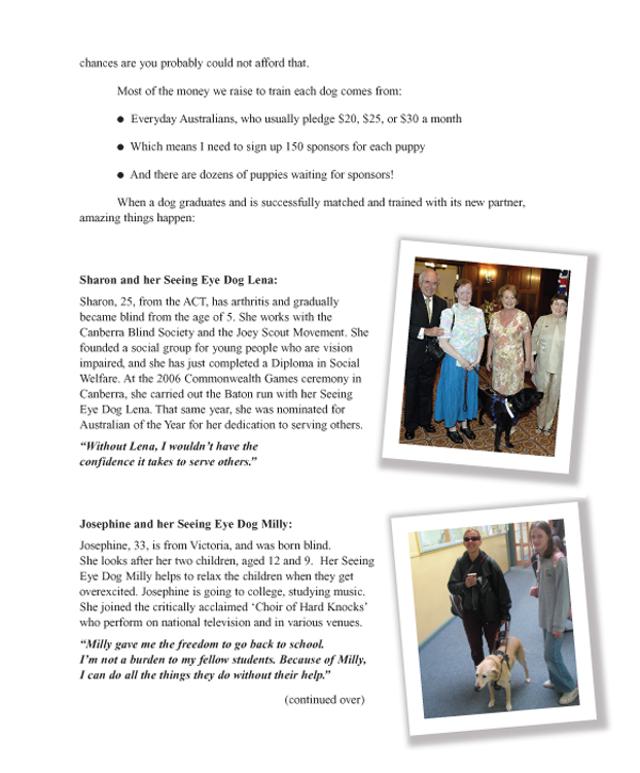Seeing Eyes for Blind People: sponsor a puppy who’ll grow into a seeing eye dog
- Exhibited by
- Derek Glass.
- Added
- June 19, 2012
- Medium of Communication
- Direct mail
- Target Audience
- Individuals, regular gift
- Type of Charity
- Environmental / animals
- Country of Origin
- Australia
- Date of first appearance
- July, 2007
SOFII’s view
Sponsor-a-dog monthly giving schemes are not new but still remain a perennial favourite with donors. This classic direct mail appeal is worthy of attention because of the creative use of the simple questionnaire as an involvement device; and the way that the proposition has been cleverly tailored to appeal to its Australian audience. Focusing on cuddly puppies being trained as guide dogs is a cunning finishing touch and, of course, entirely appropriate for this charity. See also comments in the 'merits' section, below.
Creator / originator
Derek Glass, Derek Glass Direct Marketing, Sydney Australia, with Amel Bendedouche, direct marketing manager at SEDA. Designed by Craig Woodhead.
Summary / objectives
Now on its seventh rollout since first testing less than two years ago, this direct mail package has been very successful as a cold mail 'acquisition' appeal with a high value monthly giving ask. In Australia they would say it 'reaches for the high bar' – in other words, it aspires to be just as hard working as it can be.
Background
Three simple facts:
- It costs A$30,000 to train a seeing eye dog.
- The Australian government provides no funding for the training of seeing eye dogs and
- There is a two year waiting list to get a seeing eye dog.
These three facts created the perfect 'case for giving' to support this monthly giving programme.
Special characteristics
The editorial style used is worth noting. Quick, short sentences, written at an easy reading/comprehension level, few big words. A very low word count on page 1 'draws' the reader in. Explicit Australian icons such as a flag on the envelope are reinforced inside with more subtle cultural cues. The three testimonials are from people who match the 'Quiet Achiever', 'Battler Mum', and 'Digger' archetypes that resonate with the Australian audience (*see explanation below).
The lift postcard from a puppy called Gina is a classic of the dog sponsorship genre. She says, 'Hi, my name is Gina and I'm one of the new schoolies at Camp SEDA'. Some readers may find the style a bit yucky, but it's just good fun and donors love it.
Influence / impact
Puppy sponsorship numbers have tripled since the introduction of this package.
Details
The package generates three response rates. There is a no gift, survey-only response, a cash response and a puppy sponsor (monthly donor) response. Follow- up campaigns are developed to convert both cash and survey respondents to monthly giving, using direct mail and telemarketing.
Results
When first tested, it beat the current banker package by a factor of 5:1.
Merits
It shows an unusual and daring editorial style that dramatically reduces the amount of time it takes someone to read the letter. The full case for giving is communicated within that crucial first 10 seconds, which is when someone is deciding whether to read your letter or bin it.
Other relevant information
The Quiet Achiever – is someone who is talented, successful, a natural born high achiever. But, one who is very quiet about it, NOT boastful. People like this are very highly respected. The girl in the first story, pictured with former Prime Minister John Howard, was named a 'Young Australian of the Year'. She recently graduated from university and has a long list of admirable accomplishments (as told in the letter).
The Battler Mum – usually has a few children, who perhaps also works, or lives frugally on her husband's earnings. She sacrifices a lot for her children, and is a 'battler', meaning she goes to great effort to create the best life for her family, usually in the face of many challenges. This is also very highly respected in Aussie culture.
The Digger – A 'digger' is a soldier. The term comes from World War 1, when the Australians fought in the trenches and were often the ones given the task to dig the trenches. The story in the letter is about a man who lost his eyesight in a military training accident. In other words, he was serving his country when he went blind. Something anyone can relate to empathetically, no matter where you are from.
All three archetypes are common to many cultures, of course, and these types of people are respected everywhere. But in Australia, they are particularly revered and celebrated in popular culture, literature, music, and so on. And the three terms are immediately recognised by any Australian.
 View original image
View original image
 View original image
View original image
 View original image
View original image
Also in Categories
-
-



















